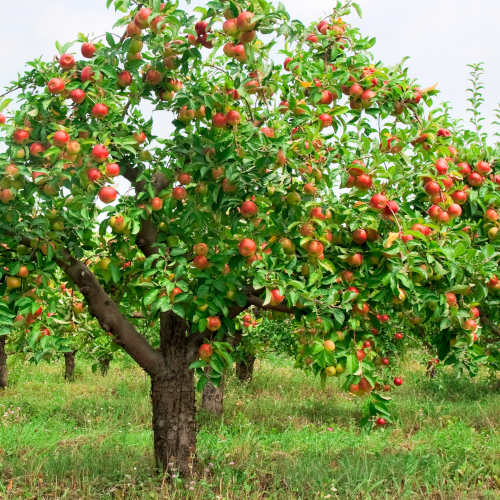Albuquerque Landscaping with Fruit Trees – Part Two

Imagine sinking your teeth into a fresh, juicy peach plucked straight from a tree in your own Albuquerque yard. Homegrown fruit is such a treat! To make this vision a reality, you need to pick the perfect spot for your fruit tree to thrive.
Fruit trees aren’t like other landscaping plants. They need lots of space to reach full size and soak up sun. You also have to care for them in special ways, especially when they’re young.
Here are the tips to find the ideal site and care routine to grow a robust fruit tree in your Albuquerque landscaping that rewards you with bountiful harvests.
Don’t Skimp on Space for Your Tree
When shopping for baby fruit trees, it’s tempting to picture them staying cute and compact. But most quickly grow into massive giants! You need to account for their mature size.
Before buying a fruit tree, look up how tall and wide it will ultimately get. This gives you a sense of the room it requires.
As a rule of thumb, space fruit trees:
- 15-20 feet between trees planted in a line
- 15 feet from fences, houses, etc.
- 25+ feet between dwarf varieties
Without adequate space, you’ll end up pruning constantly or needing to remove trees. Plus, neighbors won’t appreciate fruit dropping into their yard!
Give your tree area to reach its intended size. Site it thoughtfully to avoid future hassles.
Sunlight Needs Vary by Fruit Variety
Sun-worshipping fruit trees like peaches and cherries require a spot receiving full sun for at least 6-8 hours per day. Partial shade means less fruit.
Apple, pear and plum trees are slightly more flexible, needing 4-6 daily hours of sun. But more light equals better quality fruit.
Study how sunlight hits different areas of your yard at different times and seasons. Choose the spot getting the most sun overall.
Also consider future shade from nearby plants and structures as they grow taller. Don’t let them steal your tree’s light later on!
Caring for Trees Takes Time and Effort
Fruit trees require proactive, attentive care as they mature-much more than other landscape plants. Don’t expect a hands-off tree!
Provide deep weekly watering for young trees. Monitor mature trees and water during dry periods.
Use organic fertilizer to feed trees in early spring and after fruiting. Prune annually to remove unhealthy growth.
Watch for pests and diseases. Treat promptly to maintain vigor. Stake branches, paint trunks, and protect from weather.
Commit to staying on top of your tree’s needs. This dedication results in robust health and plentiful fruit.
Prevent Fruiting the First Few Years
It’s exciting when a young fruit tree first blossoms. But letting it bear fruit right away strains its development.
For the first 3-4 years, your goal is to promote extensive root and branch growth without fruiting.
Removing flowers and tiny fruit forces the tree to focus energy on building a strong structure instead of making fruit.
Be diligent about pinching off blooms and little fruit during these early years. This will pay off later with a thriving, productive tree.
